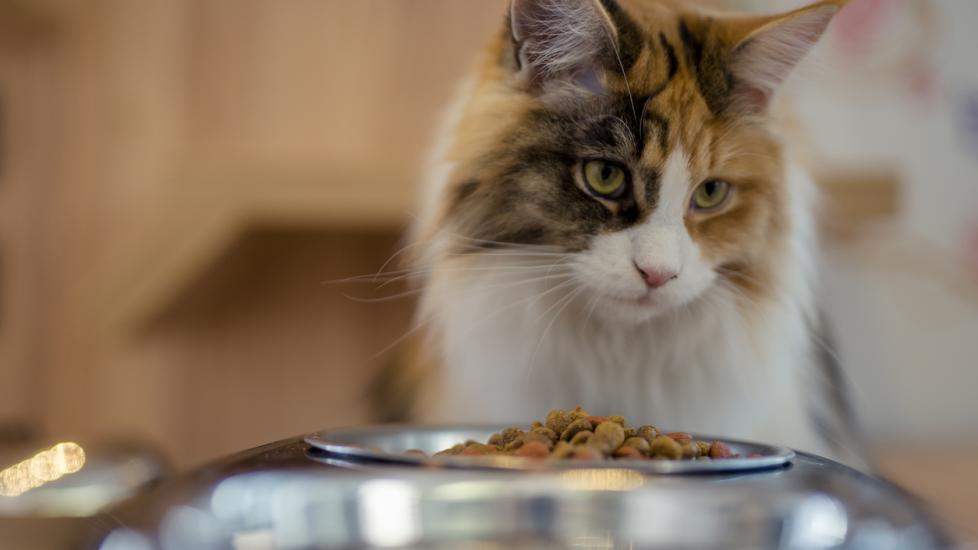What To Feed a Cat with Arthritis
Cat Arthritis Is More Common Than You Think
Most older cats have arthritis. In fact, one study showed that 90% of cats over age 12 showed signs of arthritis on X-rays.
Unfortunately, the condition often goes undiagnosed, probably because cats are so good at hiding their discomfort, and we often write off the signs of arthritis in cats as a normal sign of aging. If your cat has any of the following common symptoms of arthritis, make an appointment with your veterinarian.
-
Poor self-grooming, especially around their hind end
-
Difficulty climbing and jumping. They may no longer hang out in their favorite locations if they’re hard to reach.
-
Increased grumpiness due to pain
-
Loss of muscle mass
-
Accidents outside the litter box
-
Stiffness, particularly after rest
-
Limping (less common)
What To Look For in an Arthritis Diet for Cats
There is no magic bullet when it comes to treating arthritis in cats. Most do best with a multi-modal approach, which means using several different treatments at the same time.
Your veterinarian can chart the best arthritis treatment plan based on the specifics of your cat’s case, but diet is one tool almost always included.
The best diet for a cat with arthritis will accomplish several important goals:
-
Promote a healthy weight: Overweight cats need to slim down. Extra body fat puts stress on painful, arthritic joints and increases inflammation in the body. A cat with arthritis should be a little on the thin side with a body condition score around 4.5/9.
-
Maintain strong muscles: Arthritic cats tend to not want to be active and lose muscle mass as a result. Arthritis diets for cats should be high in protein (usually no less than 35% on a dry-matter basis) to keep the muscles that support joints strong.
-
Promote joint health: Adding supplements like glucosamine, chondroitin, and omega-3 fatty acids can help joint cartilage stay healthy, improve the quality of joint fluid, and reduce joint inflammation.
Cat Food with Glucosamine
Glucosamine is often the first ingredient that comes to mind when pet parents are looking for an arthritis diet for their cats. It is often combined with chondroitin because the two supplements seem to work better together to:
-
Prevent or decrease the breakdown of joint cartilage
-
Promote the formation of new cartilage
-
Increase the production of joint fluid
-
Decrease joint inflammation
However, glucosamine and chondroitin aren’t the only ingredients to look for. DHA (docosahexaenoic acid) and EPA (eicosapentaenoic acid) are both omega-3 fatty acids that act as potent anti-inflammatories. Cold water fish oils are the best source of omega-3 fatty acids, since cats can’t metabolize the form found in flaxseed and flaxseed oil.
Prescription Arthritis Diets for Cats vs. Homemade Arthritis Diets for Cats
For cats with moderate to severe arthritis, veterinarians may recommend a prescription cat food that accomplishes one or two of the goals of an arthritis diet for cats, and then add nutritional supplements to round out the treatment plan. Here are a couple examples:
-
Hill's® Prescription Diet m/d is a prescription weight loss diet for cats that is high in protein. It could be combined with Nutramax® Dasuquin Hip & Joint Soft Chews Joint Supplement for Cats to add glucosamine, chondroitin, DHA, and EPA.
-
Since most cats with arthritis are older, they may also have kidney disease. In these cases, a veterinarian may prescribe Hill's® Prescription Diet k/d Kidney Care + Mobility Care, perhaps in combination with Nutramax® Cosequin Hip & Joint with Glucosamine & Chondroitin Capsules Joint Supplement for Cats.
Another option for arthritic cats is a homemade diet, but in most cases combining a good, commercially available cat food for arthritis with appropriate nutritional supplements is safer and more effective.
How To Cook for Cats With Arthritis
Home cooking can be a good option for extremely finicky cats. An arthritis diet isn’t going to do a cat any good if it’s left in the bowl! Recipes online or in books are almost always inappropriate for long-term feeding. Instead, consult a veterinary nutritionist, or services like PetDiets.com or BalanceIT.com, which are run by veterinary nutritionists and involve your veterinarian. They can provide recipes for your cat’s specific needs that contain all necessary supplements to treat arthritis and prevent nutritional deficiencies.
How To Transition Your Cat to an Arthritis Diet
Cats often develop strong dietary preferences, so whenever you switch to a new food, do it slowly. Over 10–14 days, gradually mix increasing amounts of your cat’s new food with decreasing amounts of their old food. If your cat decides not to eat at any point, go back to the previous day’s mixture; don’t try to add more new food until they are eating well again.
Signs to Watch for After Starting Your Cat on an Arthritis Diet
Not eating the new food is the most common problem that develops when switching cat foods, but sometimes more serious problems arise. Call your veterinarian for advice if your cat develops gastrointestinal symptoms like vomiting or diarrhea, or they won’t eat for more than 24 hours, even when you switch back to their old food.
What To Feed a Cat with Arthritis FAQs
What is the best cat food for senior cats with arthritis?
No single food is ideal for all senior cats with arthritis. Your veterinarian can help you pick the best option for your cat, but two to consider are American Journey Senior Pate Wet Cat Food and ORIJEN Guardian Senior 7+ Grain-Free Dry Cat Food . These are the most appropriate for cats with mild arthritis or in combination with other types of arthritis treatments.
What causes arthritis flare-ups in cats?
A cat’s arthritis symptoms may suddenly worsen after they have been especially active or experience an injury (after a fall, for example). Arthritis is a progressive disease, however, so a cat’s symptoms will usually get worse over time.
Featured Image: iStock.com/D-Keine
